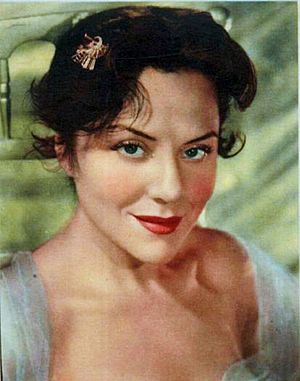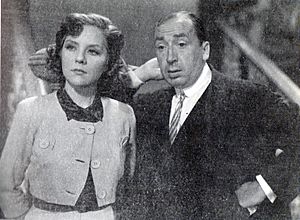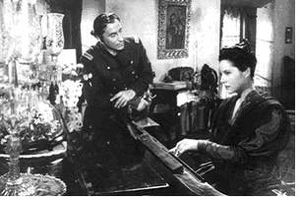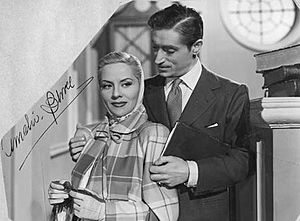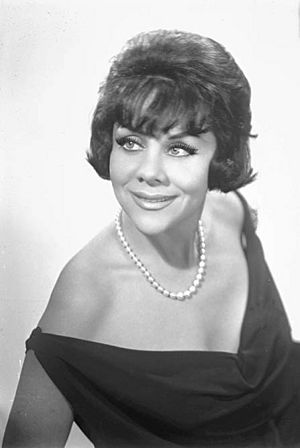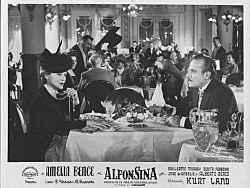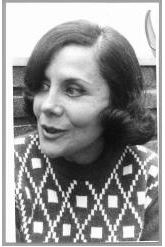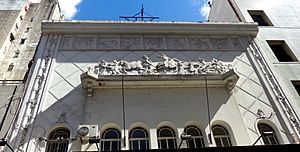Amelia Bence facts for kids
Amelia Bence (born María Amelia Batvinik; 13 November 1919 – 8 February 2016) was a famous Argentine film actress. She was considered one of the biggest stars, or divas, during the Golden Age of Argentine Cinema, which lasted from the 1940s to the 1960s.
Amelia was born to Jewish immigrants from Belarus. She started acting when she was very young. She studied at the Lavardén Children's Theater and the National Conservatory of Music and Speech. Her first movie was Dancing in 1933, which was only the second sound film ever made in Argentina.
Amelia became very well-known for her acting in La guerra gaucha (1942). This film is one of the most important in Argentine cinema history. After this, she got many main roles in movies. She starred in films like Los ojos más lindos del mundo (1943), Todo un hombre (1943), Camino del infierno (1946), and Danza del fuego (1949). She won several awards for Best Actress, including from the Argentine Academy of Cinematography Arts and Sciences and the Silver Condor Award for Best Actress. Her work was also recognized with awards in Spain, Cuba, and the US during the 1940s and 1950s.
In the 1950s, Amelia filmed two movies in Mexico. She received great praise for her main role in Alfonsina (1957), a film about the poet Alfonsina Storni. This movie was chosen to represent Argentina at the Berlin International Film Festival. In the 1960s, Amelia also had a very successful career in theater, performing in many plays.
From 1973 to 1976, she toured Latin America. She also performed in "La valija" ("The Suitcase") at the Gramercy Arts Theater in New York City. For this role, she won an Association of Latin Entertainment Critics (ACE) Award for Best Foreign Actress. Her performances in "Doña Rosita, la soltera" (1975) and "La loba" (1982) in the United States and Peru were also very popular.
Later in her career, she acted in several TV shows, such as Romina, Bianca, and Las 24 horas. She received a Lifetime Achievement Award in 1989 and more awards in the same category in 1992 and 1997. Between 1996 and 2010, she performed her show "Alfonsina," which combined music and poetry. After working for eight decades, she retired in 2010.
Contents
Biography
Early Life and First Steps in Acting
María Amelia Batvinik was born on 13 November 1914 in Buenos Aires, Argentina. She was the youngest of seven children. Her parents were Jewish immigrants from Belarus. From a young age, Amelia loved acting and would perform with other children in her neighborhood. A neighbor, Paulina Singerman, suggested that Amelia's mother enroll her in the Lavardén Children's Theater.
At age five, Amelia officially debuted on stage. She was encouraged by the sisters Paulina and Berta Singerman, and performed in a play called "Juanita" by the poet Alfonsina Storni. Amelia also studied piano and later worked as an elevator operator. Even though her family didn't want her to be an actress, she convinced her mother to let her continue studying. She learned classical dance and even filled in for a star performer in a ballet when the main actress got sick.
First Films and Stage Successes
Amelia's first movie role was a small part in Dancing (1933). The director, Luis José Moglia Barth, gave her the stage name "Amelia Bence." This film wasn't very successful, so Amelia went back to theater. She worked in musical comedies and vaudeville shows. In one play, "Baile en el Savoy," she replaced the main star and performed with Florencio Parravicini. This play was one of her first big successes, with over 100 performances.
In 1937, Amelia took on a more serious role in the drama La fuga. Her performance earned her a contract with Pampa Film. After some other roles, she filmed La vuelta al nido (1938), which she considered one of the best films of its time.
In 1938, Leopoldo Torres Ríos gave Amelia her first main role in a movie called Adiós Buenos Aires. She played a showgirl living a bohemian life. That same year, she gained a lot of attention for her role in the play Mujeres. In one scene, she appeared to be bathing in a tub full of foam. She said this scene had a "very big impact" on her career. The play was very popular, with 250 performances.
Becoming a Recognized Star
After her successful theater season, Amelia filmed El matrero (1939). She played a girl who falls in love and is accused of a crime. Her performance was praised, and she signed a three-year contract with San Miguel Studios, which became the biggest film studio in Argentina. In 1941, she starred in La casa de los cuervos, for which she won an award for Best Actress.
In early 1942, Amelia filmed El tercer beso. The movie was a success, and she won the Silver Condor Award for Best Actress for her role. This recognition led to her being featured on magazine covers and receiving an offer for La guerra gaucha. This film is considered one of the most important in Argentine cinema history. It was set in northern Argentina in the early 1800s and showed the gauchos' fight against Spanish rule. The film won seven awards, and Amelia won an award for best actress from the City of Buenos Aires. She even received an offer to work in Hollywood, but she turned it down.
A Leading Lady in Film
After the success of La guerra gaucha, Amelia Bence only received leading roles. In 1943, she starred in Son cartas de amor, a romantic story. She won an award for Best Actress from the Cuban Federation of Film and Theater Editors for this film. Later in 1943, she starred in Los ojos más lindos del mundo (The Most Beautiful Eyes in the World). This title referred to her unique purplish-green eyes and became her nickname.
Her next film, Todo un hombre (1943), earned her another Best Actress award. In 1946, she starred with Mecha Ortiz in Camino del infierno, a psychological thriller. Later, San Miguel Studios put Amelia, Mecha Ortiz, and María Duval together in Las tres ratas (1946), which was very popular.
In 1944, Amelia met actor Alberto Closas while filming in Chile. They later married. One of their films, Lauracha (1946), was delayed due to a legal dispute. Despite the delay, Amelia won the Silver Condor Award for Best Actress for her role as a strong, independent young woman. In 1947, she won another award for her role in A sangre fría, where she played a wealthy lady mistreated by her nephew.
For her role in La otra y yo (1949), Amelia dyed her hair blonde to play two different characters in the same film. This surprised the audience, as there was a scene where both characters talked to each other. Amelia also starred in Danza del fuego, playing a concert pianist. Her performance earned her Best Actress awards in 1949.
After marrying Alberto Closas in 1950, they formed a theater company. Their first play, "La estrella cayó en el mar," was a big success. However, Amelia later said she was "blacklisted" by the government at the time, which meant she had trouble getting work, even though she wasn't involved in politics. Despite this, she and Closas continued to tour with their plays.
Mid-Century Career
In the 1950s, Amelia worked for Reforma Films in Mexico. Her first Mexican film was Siete Mujeres (1953). She found filming in Mexico very different, with fewer opportunities for retakes. After ten months, Amelia returned to Argentina and ended her marriage with Closas.
In 1955, the play "Pesadilla" premiered and toured successfully. Amelia also opened "La dama del trébol." However, a political change in Argentina (the 1955 coup d'état) caused problems for her career. Her new partner, José María Fernández Unsáin, had worked for the previous government. This led to threats at theaters and cancellations of her shows.
In 1957, Amelia began filming her favorite movie: Alfonsina, based on the life of poet Alfonsina Storni. Amelia decided to play the role without special makeup, relying only on her acting. She won the Best Actress award from the Argentina Film Academy, and the film was chosen for the 1957 Berlin International Film Festival. Foreign critics praised her performance. That same year, she also started appearing on television.
Amelia's meeting with director José María Forqué in Europe led to her starring in De espaldas a la puerta (1959), a crime drama. She won an award for Best Foreign Actress for this role. Back in Argentina, she performed in "Así es la vida" and "Maribel y la extraña familia," both of which were very successful.
International Work and Later Years
In 1962, Amelia attended the International Film Festival of India. Back in Argentina, she starred in a low-budget film called La cigarra no es un bicho, which aimed to help the national film industry. The film was very popular, and Amelia and her co-star Luis Sandrini were honored as the best Argentine artists of the year by Chilean journalists.
From 1963 to 1964, she toured with her plays in Argentina and Uruguay. In 1964, she also had a successful theater season in Chile. She starred in La industria del matrimonio, a film made of different stories, where she played a wealthy single woman. In 1968, she performed in the classic play "Cándida".
At the end of 1968, Amelia decided to go on a long tour through Latin America, including Colombia, Venezuela, the Dominican Republic, Puerto Rico, and Miami. She performed several plays and received good reviews. After returning, she performed in "Flor de cactus" and toured more Argentine cities.
In 1972, she was invited to New York to perform in "La valija" (The Suitcase) at the Gramercy Arts Theater. The New York Post praised her performance. She toured with the show to various US cities, including Washington, D.C., and Miami. For her work, she won the Association of Latin Entertainment Critics (ACE) award for Best Foreign Actress. In 1973, she made her first color film, Adiós, Alejandra. In 1975, she performed "Doña Rosita, la soltera" in the United States and met the famous actress Katharine Hepburn. She later took the show to Peru.
In the early 1980s, Amelia appeared frequently on television in shows like Dulce fugitiva, Romina, and Bianca. Her play "La loba" was very successful in Peru and was also aired on Peruvian television. In 1985, she starred in a Peruvian soap opera, which made her even more popular.
Final Years and Tributes
Around 1986, Amelia started getting fewer acting offers. In 1987, she took a role in the play "Solo 80," which received good reviews but didn't attract many people. After almost two years without work, she traveled to Cuba in 1989 and met Fidel Castro. Later that year, she received the Silver Condor Award for Lifetime Achievement. In 1992, she also won the Pablo Podestá Prize for Lifetime achievement.
In 1990, Amelia reunited with her former husband, Alberto Closas, to act in "Cartas de amor." She then went on a long tour for 21 months with the play "Esta noche hablamos de amor." In the 1990s, she also worked in television series like Esos que dicen amarse and Con alma de tango.
In 1998, Amelia received a Golden Ángel "Cholo" Peco award. She also performed in "Hoy ensayo Hoy" with other experienced actors. In 2002, she starred in the play "Venecia" in Peru. In 2003, she tried children's theater with "Amor invisible." She returned to television in 2004 in the comedy series No hay dos sin tres, for which she was nominated for an award.
In her later years, Amelia received many awards for her long career. In 2006, she was honored by the Actors Social Work. In 2007, she received the first Javolandia Award for lifetime achievement and a certificate of recognition at the María Guerrero Awards. In 2008, she received the Trinidad Guevara Achievement Award. In 2009, a tribute was held in her honor, and a hall was named after her.
For 14 years, Amelia performed her one-woman show, "Alfonsina." In 2010, she had surgery after a fall. In 2011, she was declared an "Outstanding Personality of Argentine Culture." Soon after, she published her memories in a book called La niña del umbral: Amelia Bence: memorias. In 2012, a documentary filmed in 2010, El día que cambió la historia, was released. It was her first film in 40 years and was about the labor movement during the Perón government.
Personal life
Amelia Bence had a relationship with Roberto Fernández Beyró from 1941 to 1944. She later married Spanish actor Alberto Closas in 1950. They worked together in films and plays. Their marriage ended in 1953, but they remained friends and even worked together again.
In the mid-1950s, she had a brief romance with writer José María Fernández Unsáin. From 1964 to 1970, she was in a relationship with Osvaldo Cattone, who also directed her in some plays. Her last husband was "Charlie" Ortiz Basualdo, whom she lived with from 1980 to 1982. Amelia stayed active and healthy, doing yoga and maintaining a good diet, until she suffered a hip fracture.
Death
Amelia Bence passed away on 8 February 2016, in Buenos Aires, at the age of 96.
Legacy
Amelia Bence left behind a film legacy that spans eight decades. In 1973, she was given the keys to the city of Miami. In 1981, a room at the Pablo C. Ducrós Hicken Museum of the Cinema was named after her to recognize her as a "first figure of national cinema." In 1995, the Senate of Argentina honored her for her contributions to Argentine culture. Two years later, she received a lifetime achievement award from the National Endowment for the Arts. In 2007, she became an honorary member of the Academy of Motion Picture Arts and Sciences of Argentina.
Throughout her career, she was called "the face of Argentine film" and was known for having "the most beautiful eyes in the world." Amelia believed that her acting work was the most important part of her legacy. In 2010, a journalist named Daniel Gómez Rinaldi published a book about her life called Amelia Bence: Los ojos más lindos del mundo.
Autobiography
- Bence, Amelia; Etchelet, Raúl. La niña del umbral: Amelia Bence: memorias Buenos Aires, Argentina: Corregidor (2011) (in Spanish)
Filmography
Films
- Dancing (1933)
- La fuga (1937)
- El forastero (1937)
- Adiós Buenos Aires (1938)
- La vuelta al nido (1938)
- Los caranchos de la Florida (1938)
- Hermanos (1939)
- El matrero (1939)
- El haragán de la familia (1940)
- Novios para las muchachas (1941)
- La casa de los cuervos (1941)
- El tercer beso (1942)
- En el viejo Buenos Aires (1942)
- Cruza (1942)
- La guerra gaucha (1942)
- Son cartas de amor (1943)
- Los ojos más lindos del mundo (1943)
- Todo un hombre (1943)
- Nuestra Natacha (1944)
- Veinticuatro horas en la vida de una mujer (1944)
- Camino del infierno (1945)
- Las tres ratas (1946)
- María Rosa (1946)
- Lauracha (1946)
- El pecado de Julia (1948)
- A sangre fría (1947)
- La otra y yo (1949)
- La danza del fuego (1949)
- La dama del collar (1949)
- Romance en tres noches (1950)
- Mi mujer está loca (1952)
- La Parda Flora (1952)
- Siete Mujeres (1953)
- Las tres Elenas (1954)
- El hombre que debía una muerte (1955)
- Alfonsina (1957)
- Dos basuras (1958)
- De espaldas a la puerta (1959)
- La cigarra no es un bicho (1963)
- La industria del matrimonio (1964)
- Los debutantes en el amor (1969)
- Adiós, Alejandra (1973)
- El día que cambió la historia (2012) (documentary)
Television
- Los premios Nobel (1958) (mini-series)
- Topaze (1960) (mini-series)
- Espectáculo eléctrico estándar (1965) (mini-series)
- Dulce fugitiva (1979)
- Bianca (1980)
- Romina (1980)
- Las 24 horas (1981)
- Esos que dicen amarse (1993)
- Son o se hacen (1997)
- No hay 2 sin 3 (2004)
See Also
 In Spanish: Amelia Bence para niños
In Spanish: Amelia Bence para niños
- List of centenarians (actors, filmmakers and entertainers)


